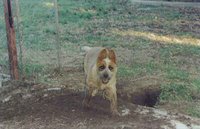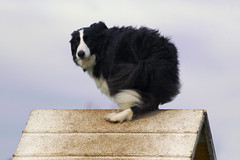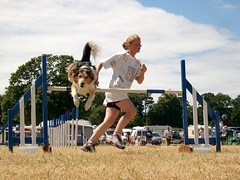Last weekend Dusty and I went to our third herding clinic at Uralla with Robert and Jenny Cox. Wonderfully organized by Sue Selby. I was going to try Thommo with the sheep, but when we stopped on the way, he ripped that nail off again in a rocky creek bed. I had prepared him to wear a muzzle, putting in on for longer periods and rewarding him for tolerating it, in case he wanted to grip the sheep. In the end I put it on while the vet removed the nail completely, though it was probably unnecessary - he didn't look like he was going to bite anyone, just looked very sorry for himself.
We had been asked to come prepared to say what our dog had learned so far. Dusty's previous clinics had been at four months and six months. At the first she learned that sheep are fun. At the second she learned that she has some power over the sheep to control their actions. So at this clinic we were to start learning that this sheep herding game has rules.
Our first session in the yard was a basic re-familiarization. Dusty was allowed to follow the sheep around without any pressure on her. Then Robert said that she was focused more on me than sheep, that she was just going for a walk with me and the sheep. He told me to grab one of the sheep, which I did. Dusty bit me on the butt. When he could stop laughing Robert said, "See I told you she was focused on you." But it did transfer her attention. She very nicely returned a breakaway sheep to the group, and looked like she was herding.
Next turn, we used a sorting pole or stock stick to give her change of direction signals. Dusty is right-handed and naturally herds in a clockwise direction. We had done some work on this 'dry' clicking and rewarding when she changed direction when I put the stick out in front of her. But with the sheep it was a different story. Robert had a plastic bag tied to the end so it made quite a noise when he wanted it to. When she ignored the stick, he flapped it vigorously. She then decided she wasn't going anywhere near Robert or the stick. So we worked through this, calling her back to the sheep, presenting the stick and flapping it if she ignored it. I must admit I found this hard - "He's frightening my baby" - but I recognized that it was nothing compared to what a sheep or cow could do to an out of control dog. We ended the session with Robert giving her a pat and reassuring her while she investigated the bag up close.
Next turn was a real breakthrough. The bag was tied up against the stick, not flapping, and she really did respect it, changing direction when Robert put it out in front of her. We spent the session mainly working on my interaction with the sheep, moving them off the fence when necessary but otherwise standing in the centre of the yard, keeping to the other side of the flock from Dusty. Previously we had been more or less driving the sheep, with Dusty and I both behind the flock.
Last session of the day was a short, positive one. This group of sheep were a little friskier so Dusty got to have a chase of a couple of sheep that broke away. She had a nip at one out of excitement, but for the most part she worked at a steady pace. She didn't bark at all today. Last clinic she barked non-stop. I guess that is a confidence thing.
Day two was a re-enforcing of what we had learned the previous day; Dusty learned the first and foremost rule of herding is that the dog should be on the opposite side of the sheep from the handler; I learned to keep backing up to keep an eye on the dog and sheep, and turning squarely, so Dusty gets to go and "gather" the sheep toward me.
By the second session there were real signs of improvement. She was going between the sheep and the fence, I wasn't having to move them into the centre of the yard. She wasn't panicking at the sight of the flapping bag, but was seeing it as a signal to turn back - in fact she once gave it a little growl and a nip. She was moving out to go around behind the sheep, not moving directly towards them.
In our final session of the day everything went smoothly, and it felt like there was a flow to what we were doing. Robert suggested we keep the session short, ending the weekend on an upbeat note.
It will be a month before we see sheep again, but she is still a baby. There is no point in progressing beyond what she is mentally and physically capable of.






 January's author on Dog Read was Susan Thorpe-Vargas, author of Genetics and Breeding Strategies: Essays for the Dog Breeder. We have had a wonderful month discussing genes and their mutations and selecting on phenotype. One thing t
January's author on Dog Read was Susan Thorpe-Vargas, author of Genetics and Breeding Strategies: Essays for the Dog Breeder. We have had a wonderful month discussing genes and their mutations and selecting on phenotype. One thing t hat did not come up for discussion though was the digging gene, which seems to be dominant in both Darcy and Red Rose's lineage. Jenna has turned Deb's back yard into a hard hat area, permanently under construction. My back yard is paved, but by the time Dusty left our camp site last weekend it looked as though a colony of wombats had spent the weekend. And half sister Scarlet seems to have inherited the trait too. Though she obviously can't understand what the fuss is about.
hat did not come up for discussion though was the digging gene, which seems to be dominant in both Darcy and Red Rose's lineage. Jenna has turned Deb's back yard into a hard hat area, permanently under construction. My back yard is paved, but by the time Dusty left our camp site last weekend it looked as though a colony of wombats had spent the weekend. And half sister Scarlet seems to have inherited the trait too. Though she obviously can't understand what the fuss is about.



